RENAULT SCENIC 2011 J95 / 3.G Engine And Peripherals Siemens Injection Workshop Manual
Manufacturer: RENAULT, Model Year: 2011, Model line: SCENIC, Model: RENAULT SCENIC 2011 J95 / 3.GPages: 329, PDF Size: 1.71 MB
Page 291 of 329
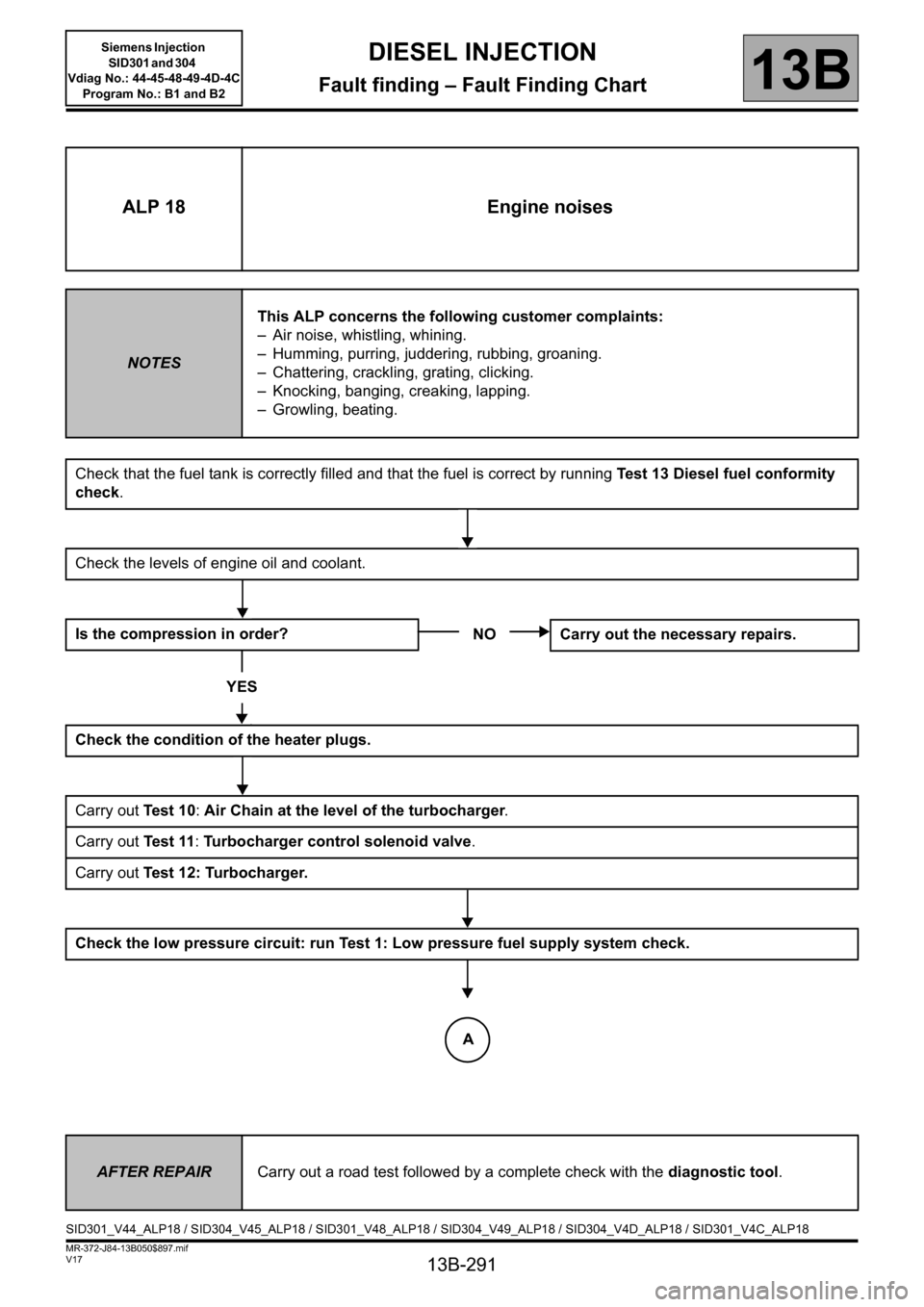
13B-291
MR-372-J84-13B050$897.mif
V17
Siemens Injection
SID301 and 304
Vdiag No.: 44-45-48-49-4D-4C
Program No.: B1 and B2DIESEL INJECTION
Fault finding – Fault Finding Chart13B
ALP 18 Engine noises
NOTESThis ALP concerns the following customer complaints:
– Air noise, whistling, whining.
– Humming, purring, juddering, rubbing, groaning.
– Chattering, crackling, grating, clicking.
– Knocking, banging, creaking, lapping.
– Growling, beating.
Check that the fuel tank is correctly filled and that the fuel is correct by running Test 13 Diesel fuel conformity
check.
Check the levels of engine oil and coolant.
Is the compression in order?
YES
Check the condition of the heater plugs.
Carry out Te s t 1 0: Air Chain at the level of the turbocharger.
Carry out Te s t 11: Turbocharger control solenoid valve.
Carry out Test 12: Turbocharger.
Check the low pressure circuit: run Test 1: Low pressure fuel supply system check.
NO Carry out the necessary repairs.
AFTER REPAIRCarry out a road test followed by a complete check with the diagnostic tool.
SID301_V44_ALP18 / SID304_V45_ALP18 / SID301_V48_ALP18 / SID304_V49_ALP18 / SID304_V4D_ALP18 / SID301_V4C_ALP18
A
Page 292 of 329
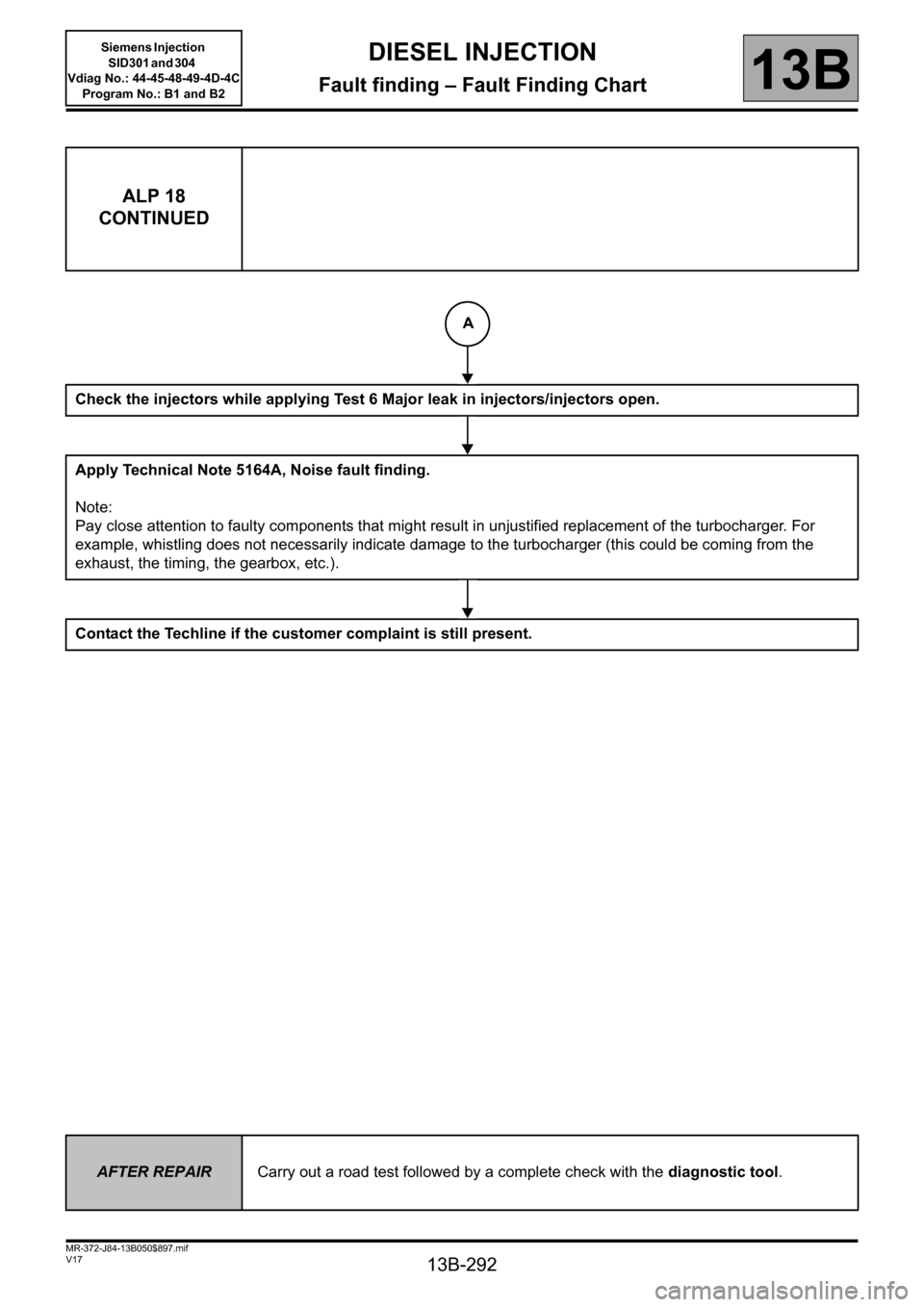
13B-292
MR-372-J84-13B050$897.mif
V17
DIESEL INJECTION
Fault finding – Fault Finding Chart
Siemens Injection
SID301 and 304
Vdiag No.: 44-45-48-49-4D-4C
Program No.: B1 and B2
13B
ALP 18
CONTINUED
Check the injectors while applying Test 6 Major leak in injectors/injectors open.
Apply Technical Note 5164A, Noise fault finding.
Note:
Pay close attention to faulty components that might result in unjustified replacement of the turbocharger. For
example, whistling does not necessarily indicate damage to the turbocharger (this could be coming from the
exhaust, the timing, the gearbox, etc.).
Contact the Techline if the customer complaint is still present.
AFTER REPAIRCarry out a road test followed by a complete check with the diagnostic tool.
A
Page 293 of 329

13B-293
MR-372-J84-13B050$897.mif
V17
Siemens Injection
SID301 and 304
Vdiag No.: 44-45-48-49-4D-4C
Program No.: B1 and B2DIESEL INJECTION
Fault finding – Fault Finding Chart13B
NOTighten the interface
or the concerned pipe.
End of procedure.
ALP 19 Oil leak from the turbocharger
NOTESThis ALP concerns the following customer complaint:
– Oil leaks from the turbocharger.
Check the area around the turbocharger
Note:
An oil leak does not correspond always to a turbocharger fault, the oil leak can arise from the area around the
turbocharger.
According to the vehicle type, maximum visual access will either be from above or from below.
1-Do not start the engine.
Check the area around the turbocharger and identify the origin of the leaks.
Clean the oil traces on the turbocharger.
2- Start the engine and let it warm up for several minutes.
IMPORTANT
If the air filter was removed previously, refit it before starting the engine (risks foreign matter entering the air inlet
circuit).
Accelerate with no load several times, progressively increasing the duration before releasing the accelerator
pedal.
Visually inspect the exterior condition of the fuel supply pipes and the turbocharger oil return and the area around
it.
Identify the origin of the leaks.
Is an oil leak present at the air compressor inlet or outlet?
YES
Check the air compressor inlet or outlet
Check for a loose interface (inlet or outlet) that is the cause of the air
leak.
Note:
It is normal to find oil traces inside the pipes at the turbocharger inlet
or outlet, because the air entering the compressor is laden with oil
from the
engine rebreathing circuit.
Is the suspected interface properly tightened?
YES
Replace the pipe concerned (see MR 364 (Mégane II), 370 (Scénic II), 417 (Kangoo II), 385 (Modus), 392 (Clio
III), Mechanical, 12B, turbocharging).
NO
AFTER REPAIRCarry out a road test followed by a complete check with the diagnostic tool.
SID301_V44_ALP19 / SID304_V45_ALP19 / SID301_V48_ALP19 / SID304_V49_ALP19 / SID304_V4D_ALP19 / SID301_V4C_ALP19
A
Page 294 of 329

13B-294
MR-372-J84-13B050$897.mif
V17
DIESEL INJECTION
Fault finding – Fault Finding Chart
Siemens Injection
SID301 and 304
Vdiag No.: 44-45-48-49-4D-4C
Program No.: B1 and B2
13B
ALP 19
CONTINUED 1
Is an oil leak present only at the casing of the compressor section?
YES NO
The turbocharger is not faulty. The oil leak is
from another engine component and the oil is
flowing onto the turbocharger.
AFTER REPAIRCarry out a road test followed by a complete check with the diagnostic tool.
A
B
Page 295 of 329

13B-295
MR-372-J84-13B050$897.mif
V17
Siemens Injection
SID301 and 304
Vdiag No.: 44-45-48-49-4D-4C
Program No.: B1 and B2DIESEL INJECTION
Fault finding – Fault Finding Chart13B
NO
End of procedure.
ALP 19
CONTINUED 2
Is an oil leak present at the turbocharger oil supply inlet or outlet?
YESNO
Check the turbocharger oil supply inlet and
outlet
Check for a loose interface (inlet or outlet) that is
the cause of the oil leak.
Is the suspected interface properly
tightened?
YES
Only replace the seal or pipe of the part concerned (see MR 364 (Mégane II), 370 (Scénic II), 417
(Kangoo II), 385 (Modus), 392 (Clio III), Mechanical, 12B, turbocharging).
Is an oil leak present at the interfaces of the turbine casing and the exhaust pipes?
YES
The turbocharger is not faulty. There is probably another fault in the engine.
Mark the component from which arises the leak and refer to the repair manual (see MR 364 (MĂ©gane II), 370
(Scénic II), 417 (Kangoo II), 385 (Modus), 392 (Clio III), 10A Engine and Peripherals).
NOTighten the pipe concerned.
End of procedure.
AFTER REPAIRCarry out a road test followed by a complete check with the diagnostic tool.
B
Page 296 of 329
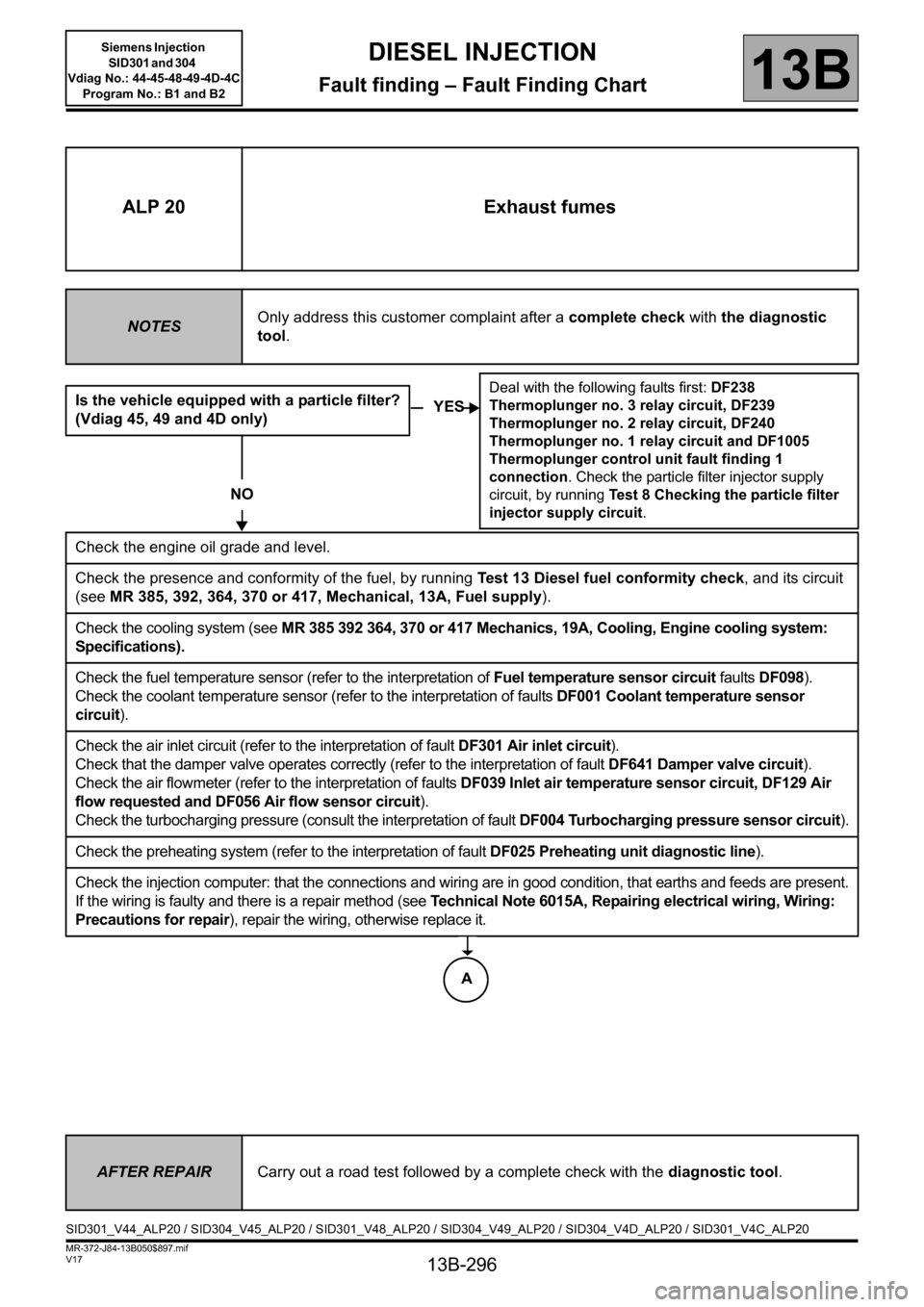
13B-296
MR-372-J84-13B050$897.mif
V17
Siemens Injection
SID301 and 304
Vdiag No.: 44-45-48-49-4D-4C
Program No.: B1 and B2DIESEL INJECTION
Fault finding – Fault Finding Chart13B
ALP 20 Exhaust fumes
NOTESOnly address this customer complaint after a complete check with the diagnostic
tool.
Is the vehicle equipped with a particle filter?
(Vdiag 45, 49 and 4D only)
NO
Check the engine oil grade and level.
Check the presence and conformity of the fuel, by running Test 13 Diesel fuel conformity check, and its circuit
(see MR 385, 392, 364, 370 or 417, Mechanical, 13A, Fuel supply).
Check the cooling system (see MR 385 392 364, 370 or 417 Mechanics, 19A, Cooling, Engine cooling system:
Specifications).
Check the fuel temperature sensor (refer to the interpretation of Fuel temperature sensor circuit faults DF098).
Check the coolant temperature sensor (refer to the interpretation of faults DF001 Coolant temperature sensor
circuit).
Check the air inlet circuit (refer to the interpretation of fault DF301 Air inlet circuit).
Check that the damper valve operates correctly (refer to the interpretation of fault DF641 Damper valve circuit).
Check the air flowmeter (refer to the interpretation of faults DF039 Inlet air temperature sensor circuit, DF129 Air
flow requested and DF056 Air flow sensor circuit).
Check the turbocharging pressure (consult the interpretation of fault DF004 Turbocharging pressure sensor circuit).
Check the preheating system (refer to the interpretation of fault DF025 Preheating unit diagnostic line).
Check the injection computer: that the connections and wiring are in good condition, that earths and feeds are present.
If the wiring is faulty and there is a repair method (see Technical Note 6015A, Repairing electrical wiring, Wiring:
Precautions for repair), repair the wiring, otherwise replace it.
YES
Deal with the following faults first: DF238
Thermoplunger no. 3 relay circuit, DF239
Thermoplunger no. 2 relay circuit, DF240
Thermoplunger no. 1 relay circuit and DF1005
Thermoplunger control unit fault finding 1
connection. Check the particle filter injector supply
circuit, by running Test 8 Checking the particle filter
injector supply circuit.
AFTER REPAIRCarry out a road test followed by a complete check with the diagnostic tool.
SID301_V44_ALP20 / SID304_V45_ALP20 / SID301_V48_ALP20 / SID304_V49_ALP20 / SID304_V4D_ALP20 / SID301_V4C_ALP20
A
Page 297 of 329
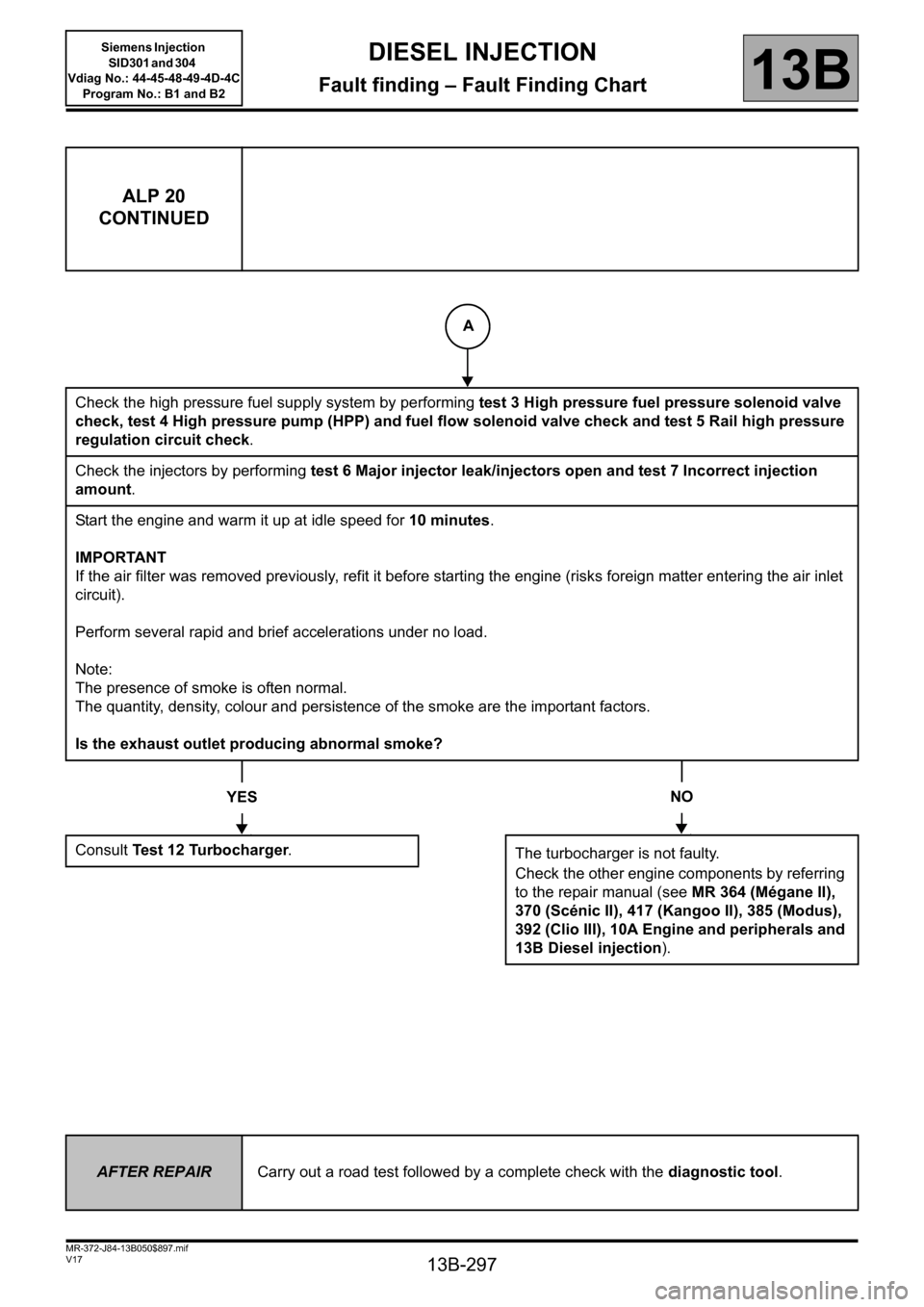
13B-297
MR-372-J84-13B050$897.mif
V17
Siemens Injection
SID301 and 304
Vdiag No.: 44-45-48-49-4D-4C
Program No.: B1 and B2DIESEL INJECTION
Fault finding – Fault Finding Chart13B
ALP 20
CONTINUED
Check the high pressure fuel supply system by performing test 3 High pressure fuel pressure solenoid valve
check, test 4 High pressure pump (HPP) and fuel flow solenoid valve check and test 5 Rail high pressure
regulation circuit check.
Check the injectors by performing test 6 Major injector leak/injectors open and test 7 Incorrect injection
amount.
Start the engine and warm it up at idle speed for 10 minutes.
IMPORTANT
If the air filter was removed previously, refit it before starting the engine (risks foreign matter entering the air inlet
circuit).
Perform several rapid and brief accelerations under no load.
Note:
The presence of smoke is often normal.
The quantity, density, colour and persistence of the smoke are the important factors.
Is the exhaust outlet producing abnormal smoke?
YES
Consult Te s t 1 2 Tu r b o c h a r g e r.
NO
The turbocharger is not faulty.
Check the other engine components by referring
to the repair manual (see MR 364 (MĂ©gane II),
370 (Scénic II), 417 (Kangoo II), 385 (Modus),
392 (Clio III), 10A Engine and peripherals and
13B Diesel injection).
AFTER REPAIRCarry out a road test followed by a complete check with the diagnostic tool.
A
Page 298 of 329
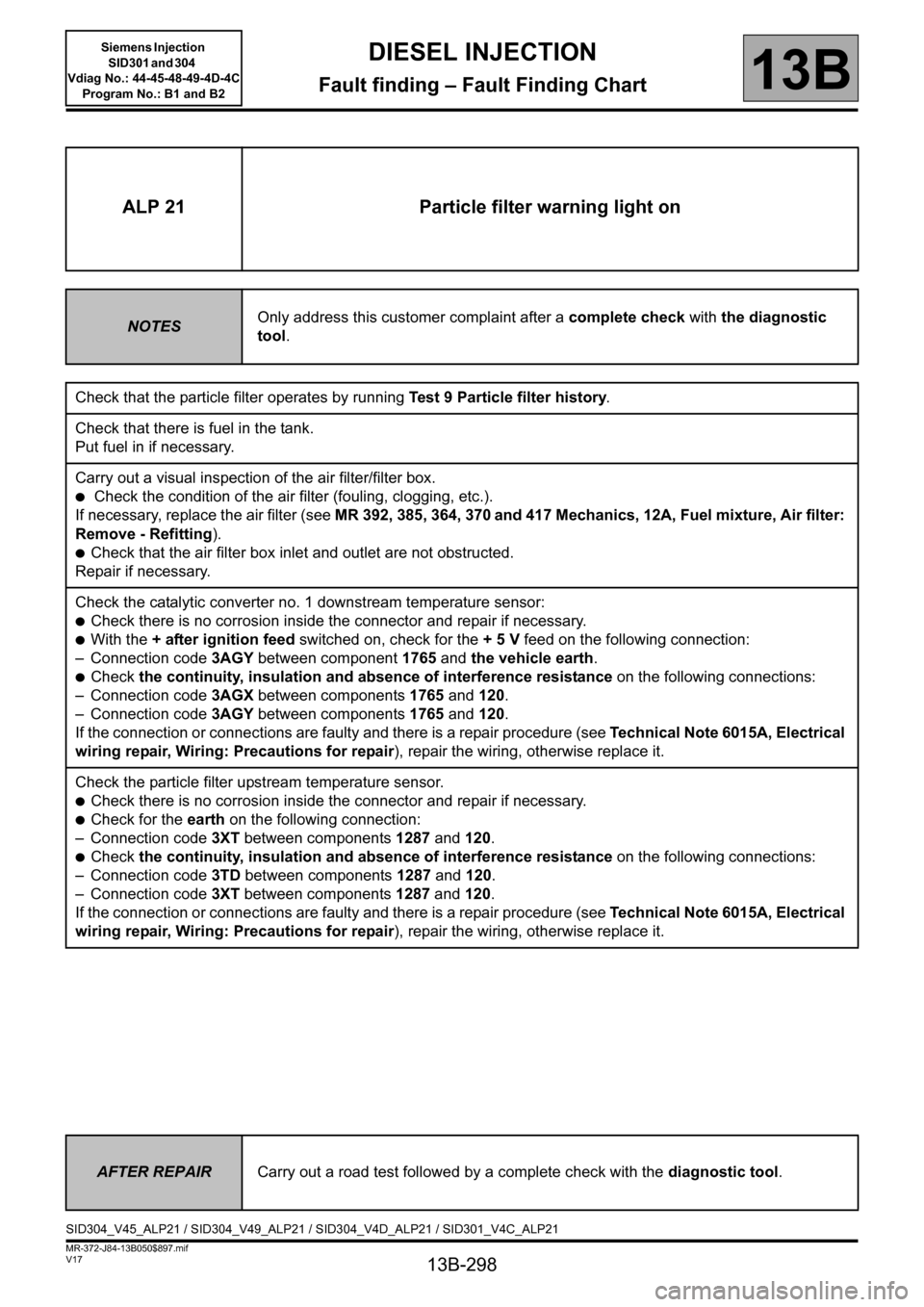
13B-298
MR-372-J84-13B050$897.mif
V17
DIESEL INJECTION
Fault finding – Fault Finding Chart
Siemens Injection
SID301 and 304
Vdiag No.: 44-45-48-49-4D-4C
Program No.: B1 and B2
13B
ALP 21 Particle filter warning light on
NOTESOnly address this customer complaint after a complete check with the diagnostic
tool.
Check that the particle filter operates by running Test 9 Particle filter history.
Check that there is fuel in the tank.
Put fuel in if necessary.
Carry out a visual inspection of the air filter/filter box.
â—Ź Check the condition of the air filter (fouling, clogging, etc.).
If necessary, replace the air filter (see MR 392, 385, 364, 370 and 417 Mechanics, 12A, Fuel mixture, Air filter:
Remove - Refitting).
â—ŹCheck that the air filter box inlet and outlet are not obstructed.
Repair if necessary.
Check the catalytic converter no. 1 downstream temperature sensor:
â—ŹCheck there is no corrosion inside the connector and repair if necessary.
â—ŹWith the + after ignition feed switched on, check for the + 5 V feed on the following connection:
– Connection code 3AGY between component 1765 and the vehicle earth.
â—ŹCheck the continuity, insulation and absence of interference resistance on the following connections:
– Connection code 3AGX between components 1765 and 120.
– Connection code 3AGY between components 1765 and 120.
If the connection or connections are faulty and there is a repair procedure (see Technical Note 6015A, Electrical
wiring repair, Wiring: Precautions for repair), repair the wiring, otherwise replace it.
Check the particle filter upstream temperature sensor.
â—ŹCheck there is no corrosion inside the connector and repair if necessary.
â—ŹCheck for the earth on the following connection:
– Connection code 3XT between components 1287 and 120.
â—ŹCheck the continuity, insulation and absence of interference resistance on the following connections:
– Connection code 3TD between components 1287 and 120.
– Connection code 3XT between components 1287 and 120.
If the connection or connections are faulty and there is a repair procedure (see Technical Note 6015A, Electrical
wiring repair, Wiring: Precautions for repair), repair the wiring, otherwise replace it.
AFTER REPAIRCarry out a road test followed by a complete check with the diagnostic tool.
SID304_V45_ALP21 / SID304_V49_ALP21 / SID304_V4D_ALP21 / SID301_V4C_ALP21
Page 299 of 329
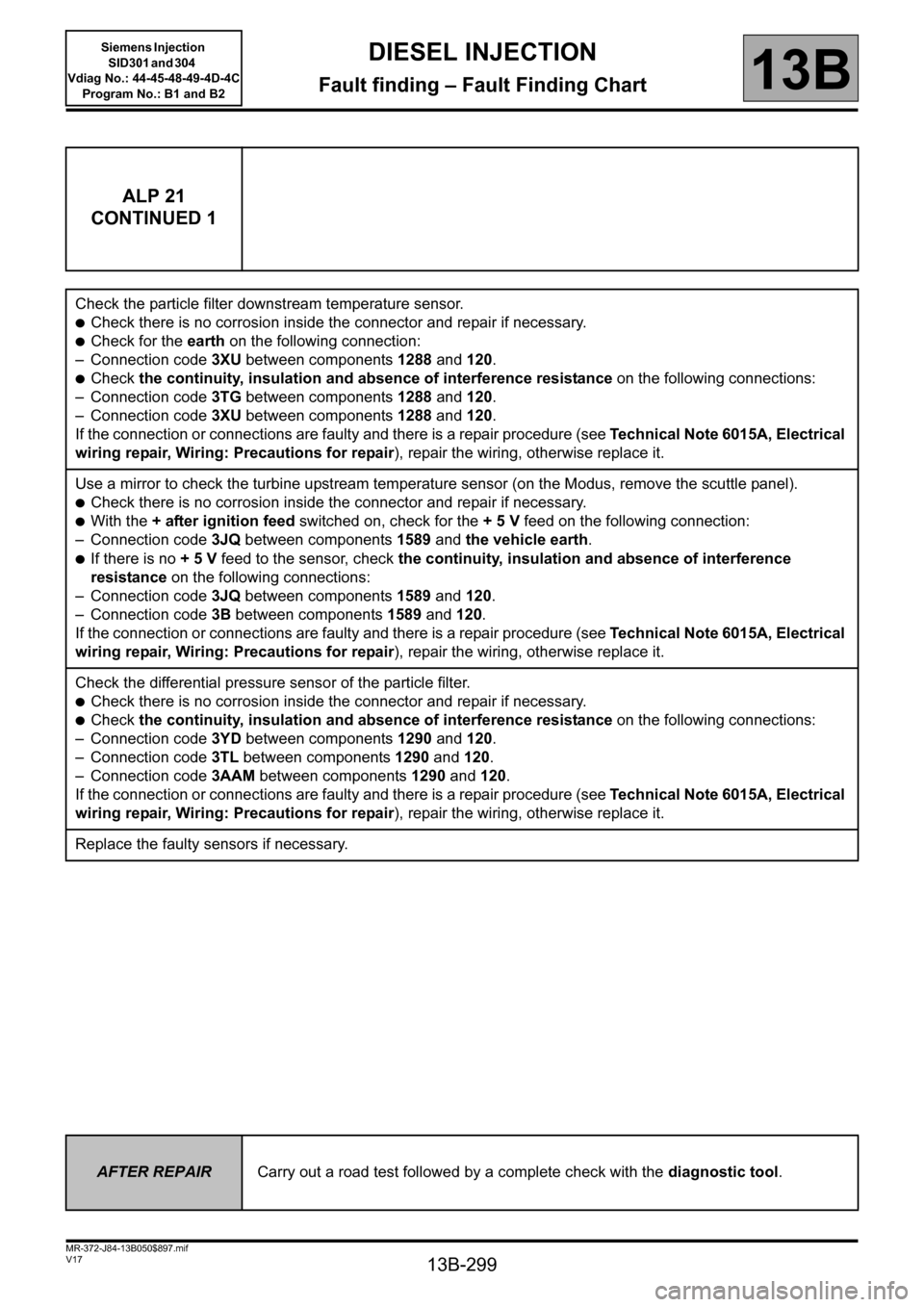
13B-299
MR-372-J84-13B050$897.mif
V17
DIESEL INJECTION
Fault finding – Fault Finding Chart
Siemens Injection
SID301 and 304
Vdiag No.: 44-45-48-49-4D-4C
Program No.: B1 and B2
13B
ALP 21
CONTINUED 1
Check the particle filter downstream temperature sensor.
â—ŹCheck there is no corrosion inside the connector and repair if necessary.
â—ŹCheck for the earth on the following connection:
– Connection code 3XU between components 1288 and 120.
â—ŹCheck the continuity, insulation and absence of interference resistance on the following connections:
– Connection code 3TG between components 1288 and 120.
– Connection code 3XU between components 1288 and 120.
If the connection or connections are faulty and there is a repair procedure (see Technical Note 6015A, Electrical
wiring repair, Wiring: Precautions for repair), repair the wiring, otherwise replace it.
Use a mirror to check the turbine upstream temperature sensor (on the Modus, remove the scuttle panel).
â—ŹCheck there is no corrosion inside the connector and repair if necessary.
â—ŹWith the + after ignition feed switched on, check for the + 5 V feed on the following connection:
– Connection code 3JQ between components 1589 and the vehicle earth.
â—ŹIf there is no + 5 V feed to the sensor, check the continuity, insulation and absence of interference
resistance on the following connections:
– Connection code 3JQ between components 1589 and 120.
– Connection code 3B between components 1589 and 120.
If the connection or connections are faulty and there is a repair procedure (see Technical Note 6015A, Electrical
wiring repair, Wiring: Precautions for repair), repair the wiring, otherwise replace it.
Check the differential pressure sensor of the particle filter.
â—ŹCheck there is no corrosion inside the connector and repair if necessary.
â—ŹCheck the continuity, insulation and absence of interference resistance on the following connections:
– Connection code 3YD between components 1290 and 120.
– Connection code 3TL between components 1290 and 120.
– Connection code 3AAM between components 1290 and 120.
If the connection or connections are faulty and there is a repair procedure (see Technical Note 6015A, Electrical
wiring repair, Wiring: Precautions for repair), repair the wiring, otherwise replace it.
Replace the faulty sensors if necessary.
AFTER REPAIRCarry out a road test followed by a complete check with the diagnostic tool.
Page 300 of 329

13B-300
MR-372-J84-13B050$897.mif
V17
DIESEL INJECTION
Fault finding – Fault Finding Chart
Siemens Injection
SID301 and 304
Vdiag No.: 44-45-48-49-4D-4C
Program No.: B1 and B2
13B
ALP 21
CONTINUED 2
Check the air flow:
â—ŹThe air flow must be approximately 250 mg/st.
Check the air flowmeter connector, component code 799 (corrosion, fouling, etc.).
If the connector is faulty and there is a repair method (see Technical Note 6015A, Repairing electrical wiring,
Wiring: Precautions for repair), repair the connector(s), otherwise replace the wiring.
Check the continuity, insulation and absence of interference resistance on the following connections:
â—ŹCode connection 3FB (3FB3 for Kangoo II) between components 799 and 1768.
â—ŹConnection code 3ABQ between components 799 and 120.
â—ŹConnection code 3DV between components 799 and 120.
â—ŹConnection code 3KJ between components 799 and 120.
â—Źconnection code 3DW between components 799 and 120.
If the connection or connections are faulty and there is a repair procedure (see Technical Note 6015A, Electrical
wiring repair, Wiring: Precautions for repair), repair the wiring, otherwise replace it.
Check the particle filter injector supply system by running Test 8 Particle filter injector supply circuit check.
AFTER REPAIRCarry out a road test followed by a complete check with the diagnostic tool.